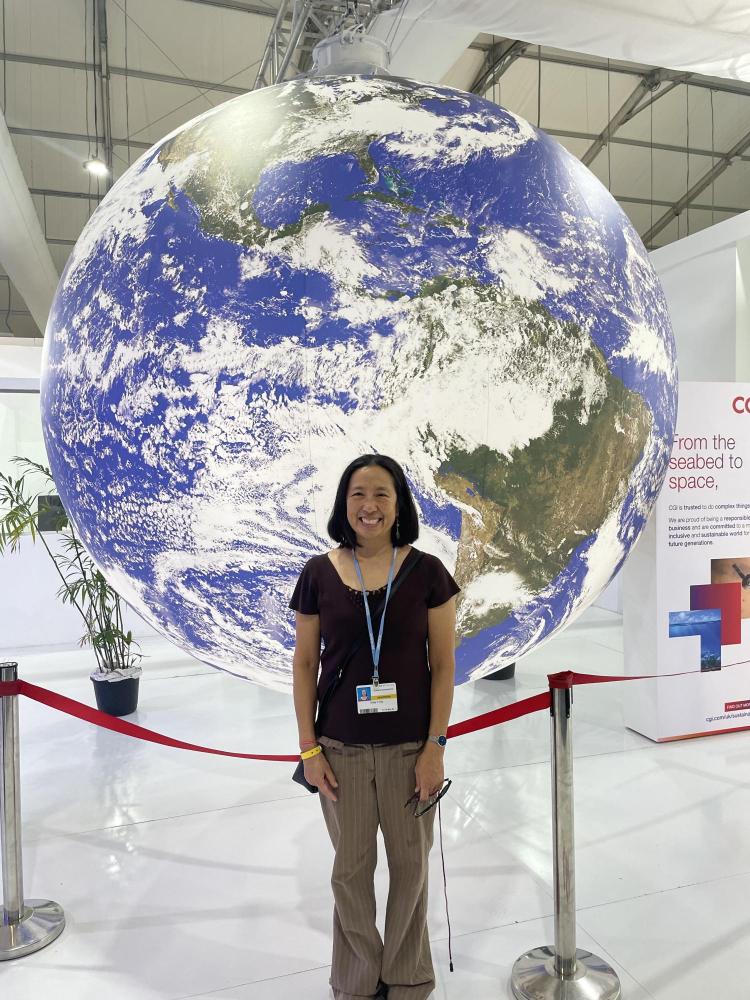COP27: Power and (in)justice in global climate governance

Our goal was to focus on the role of China at COP27 in terms of climate discourses and the question of scale in climate (in)justice. In particular, we hoped to pay particular attention to advocacy of Carbon Capture, Utilization and Storage (CCUS) and “nature-based solutions” (NbS); and positions on climate adaptation finance, and loss and damage. We generally began our days at the constituency meetings of RINGO (Research and Independent NGOs) to meet other researchers and orient ourselves toward the negotiations happening that day. We then divided our time between side events, particularly those at the China Pavilion, and observing negotiating sessions that were open to observers. We focused on negotiations on Article 6 of the Paris Agreement (on “cooperative approaches” to achieving Nationally Determined Contributions, including creating a global emissions market); the Global Goal on Adaptation; a financial mechanism for loss and damage; and in the last two days, heated negotiations over the text of the cover decision.
As was widely reported, numerous infrastructural problems plagued the conference. In its first few days, there was inadequate water to drink, food was outrageously priced within the isolated, fenced venue, participants spotted at least one sewage flood, and most observers could not watch sessions because there were far too few seats and security did not allow observers to sit on the floor. While most of these issues were resolved by the second week, sound systems remained a problem in the temporary structures that housed some of the negotiating rooms. Where headsets were not available, blowing fans, frequent airplanes flying overhead, and generally bad acoustics made it quite difficult to follow sessions in these rooms. Delegates also spent a lot of time complaining to session co-facilitators about not receiving draft negotiating texts with adequate time to review, and arguing about whether future working sessions on various agenda items should be in-person or hybrid, and on the merits of Word vs PDF documents for group work.
Because of our focus on negotiations and on China-related side events, we did not make it out to the Green Zone, the space for civil society and others without official badges. Though advertised as being “just across the street” from the official (“Blue Zone”) venue, it was in fact difficult to get there, and others reported that little was happening there beyond exhibits by local Egyptian artists and activities. Adjacent to the Green Zone was a designated “demonstration area,” a marker of the host country’s authoritarian approach to the tradition of significant street protests just beyond the COP gates. Because of the demonstration zone’s distance from the venue itself, most activist groups boycotted this space, instead focusing attention on winning UN approval for protests within the Blue Zone, where participants would be limited to those with conference badges but where visibility to negotiators, the media, and conference-goers would be higher. We witnessed Blue Zone protests that included singing and chants of “1.5 to stay alive!” “The people united will never be defeated!”, “System change, not climate change,” “Climate justice now!” and the ever-popular “Fossil of the Day” ceremony (awarded to countries who “are doing the most to achieve the least.”)
Despite the presence of activists and pavilions dedicated to Climate Justice and Indigenous Peoples, the larger pavilion space, which included both country and organization pavilions, was very corporate in message and feel. Greenwashing was prevalent. An unprecedented 636 fossil fuel lobbyists attended the COP – a greater number than all but one country delegation. The Business pavilion listed Chevron and Exxon-Mobil as being among its “partners.” OPEC had a pavilion and the Gulf States all had gigantic pavilions. Because of the expense of the pavilions, on the other hand, many sub-Saharan African states had pavilions with multiple sponsors – including oil companies.
The fact that there was finally an agreement, however vague, to establish a fund for Loss and Damage, was the only notably positive outcome – and one that was the culmination of years of activism. Although President Biden, in his plenary hall speech, apologized for the U.S. withdrawal from Paris and proclaimed that “the United States is meeting the climate crisis with urgency and with determination,”1 within the negotiating rooms U.S. delegates could be seen dragging their feet on numerous technical points. On loss and damage, they argued that existing funds should be used for this purpose, that more studies are needed on the issue, that a lengthy roll-out timeline will be necessary, and ultimately required that the text specify that the fund has nothing to do with “liability” or “compensation.” Such tactics were met with frustration and sometimes derision from other Parties. Representatives from Saudi Arabia, China, and other members of the Like-Minded Developing Country negotiating group argued against the 1.5 degree goal, and against any mention of fossil fuels. Although 1.5 fortunately remained, fossil fuels were omitted from the final cover decision. The intent is clear: to allow “mitigation” efforts to focus on CCUS and other technological solutions that allow continued extraction and burning of fossil fuels, despite high costs and uncertain mitigation benefits, instead of reductions in consumption and pursuit of the “just transition” that climate justice advocates at the COP so clearly called for. Actors from many countries, including the US, are pushing these technologies, arguing that “the math” says that it is the only option – despite much evidence to the contrary and despite activists’ arguments against false solutions.
1 https://www.whitehouse.gov/briefing-room/speeches-remarks/2022/11/11/remarks-by-president-biden-at-the-27th-conference-of-the-parties-to-the-framework-convention-on-climate-change-cop27-sharm-el-sheikh-egypt/

